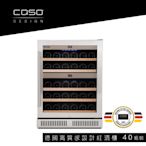紅酒櫃 相關
廣告專售冷凍冷藏設備、蛋糕櫃等,一條龍設計規劃、生產製造,亦提供短租服務,立即洽詢! ...
搜尋結果
 $99800德國 CASO 嵌入式雙溫控紅酒櫃 215瓶裝 酒櫃 獨立式溫控面板 高質感崁入式設計 歐盟規格原廠輸入 WineChef Pro180 (SW215)購物中心
$99800德國 CASO 嵌入式雙溫控紅酒櫃 215瓶裝 酒櫃 獨立式溫控面板 高質感崁入式設計 歐盟規格原廠輸入 WineChef Pro180 (SW215)購物中心 $63900LIEBHERR 利勃 獨立型單溫頂級紅酒櫃 186瓶 WKb4612購物中心
$63900LIEBHERR 利勃 獨立型單溫頂級紅酒櫃 186瓶 WKb4612購物中心 $32400LIEBHERR 利勃 獨立型單溫頂級紅酒櫃 60瓶 WKb1712購物中心
$32400LIEBHERR 利勃 獨立型單溫頂級紅酒櫃 60瓶 WKb1712購物中心 $66600LIEBHERR 利勃 除霧式獨立型單溫頂級紅酒櫃 168瓶 WKgb4113購物中心
$66600LIEBHERR 利勃 除霧式獨立型單溫頂級紅酒櫃 168瓶 WKgb4113購物中心![德國 CASO 嵌入式雙溫控紅酒櫃 40瓶裝 酒櫃 獨立式溫控面板 高質感崁入式設計 歐盟規格原廠輸入 WineChef Pro40 (SW40) 德國 CASO 嵌入式雙溫控紅酒櫃 40瓶裝 酒櫃 獨立式溫控面板 高質感崁入式設計 歐盟規格原廠輸入 WineChef Pro40 (SW40)]() $47800德國 CASO 嵌入式雙溫控紅酒櫃 40瓶裝 酒櫃 獨立式溫控面板 高質感崁入式設計 歐盟規格原廠輸入 WineChef Pro40 (SW40)購物中心
$47800德國 CASO 嵌入式雙溫控紅酒櫃 40瓶裝 酒櫃 獨立式溫控面板 高質感崁入式設計 歐盟規格原廠輸入 WineChef Pro40 (SW40)購物中心![日虎 18瓶裝質感單溫酒櫃/紅酒櫃 KU-N3706 贈清淨機一台 日虎 18瓶裝質感單溫酒櫃/紅酒櫃 KU-N3706 贈清淨機一台]() $9999日虎 18瓶裝質感單溫酒櫃/紅酒櫃 KU-N3706 贈清淨機一台購物中心
$9999日虎 18瓶裝質感單溫酒櫃/紅酒櫃 KU-N3706 贈清淨機一台購物中心![登記送7-11商品卡1900元★(全省安裝)Svago約45瓶右開紅酒櫃JG45B-R 登記送7-11商品卡1900元★(全省安裝)Svago約45瓶右開紅酒櫃JG45B-R]() $38610$42900登記送7-11商品卡1900元★(全省安裝)Svago約45瓶右開紅酒櫃JG45B-R購物中心
$38610$42900登記送7-11商品卡1900元★(全省安裝)Svago約45瓶右開紅酒櫃JG45B-R購物中心![登記送7-11商品卡1900元★(全省安裝)Svago約45瓶左開紅酒櫃JG45B-L 登記送7-11商品卡1900元★(全省安裝)Svago約45瓶左開紅酒櫃JG45B-L]() $38610$42900登記送7-11商品卡1900元★(全省安裝)Svago約45瓶左開紅酒櫃JG45B-L購物中心
$38610$42900登記送7-11商品卡1900元★(全省安裝)Svago約45瓶左開紅酒櫃JG45B-L購物中心![德國 CASO 雙溫控紅酒櫃 24瓶裝 酒櫃 獨立式溫控面板 高質感設計 歐盟規格原廠輸入 SW-24 德國 CASO 雙溫控紅酒櫃 24瓶裝 酒櫃 獨立式溫控面板 高質感設計 歐盟規格原廠輸入 SW-24]() $21800德國 CASO 雙溫控紅酒櫃 24瓶裝 酒櫃 獨立式溫控面板 高質感設計 歐盟規格原廠輸入 SW-24購物中心
$21800德國 CASO 雙溫控紅酒櫃 24瓶裝 酒櫃 獨立式溫控面板 高質感設計 歐盟規格原廠輸入 SW-24購物中心![SVAGO JG45B 134公升 紅酒櫃 SVAGO JG45B 134公升 紅酒櫃]() $38610SVAGO JG45B 134公升 紅酒櫃購物中心
$38610SVAGO JG45B 134公升 紅酒櫃購物中心![德國 CASO 雙溫控紅酒櫃 38瓶裝 酒櫃 獨立式溫控面板 高質感設計 歐盟規格原廠輸入 SW-38 德國 CASO 雙溫控紅酒櫃 38瓶裝 酒櫃 獨立式溫控面板 高質感設計 歐盟規格原廠輸入 SW-38]() $25800德國 CASO 雙溫控紅酒櫃 38瓶裝 酒櫃 獨立式溫控面板 高質感設計 歐盟規格原廠輸入 SW-38購物中心
$25800德國 CASO 雙溫控紅酒櫃 38瓶裝 酒櫃 獨立式溫控面板 高質感設計 歐盟規格原廠輸入 SW-38購物中心![ZANWA晶華 65L雙核芯電子變頻式冰箱/冷藏箱/小冰箱/紅酒櫃(ZW-65SB) ZANWA晶華 65L雙核芯電子變頻式冰箱/冷藏箱/小冰箱/紅酒櫃(ZW-65SB)]() $5680ZANWA晶華 65L雙核芯電子變頻式冰箱/冷藏箱/小冰箱/紅酒櫃(ZW-65SB)購物中心
$5680ZANWA晶華 65L雙核芯電子變頻式冰箱/冷藏箱/小冰箱/紅酒櫃(ZW-65SB)購物中心
5 天前 · 紅 べに • ( beni ) the color crimson, a vivid red edging towards pink. Synonyms: 紅色 (kurenai-iro, kōshoku, beni-iro), 丹紅 (tankō) Short for 紅花 (benibana). the safflower ( Carthamus tinctorius ), from which this color is extracted. the crimson pigment extracted from safflower petals, used in cosmetics and as a food coloring.
- 4.1K
- 1/1
- *ɡoːŋ
2023年3月17日 · For pronunciation and definitions of 红 – see 紅 (“ red; popular; in vogue; etc.”). ( This character is the simplified form of 紅 ). Notes: Simplified Chinese is mainly used in Mainland China, Malaysia, and Singapore. Traditional Chinese is mainly used in Hong Kong, Macau, and Taiwan. Categories: CJK Unified Ideographs block. Han ...
2024年3月27日 · 紅麴 - Wiktionary, the free dictionary. See also: 紅麹. Contents. 1 Chinese. 1.1 Pronunciation. 1.2 Noun. 1.2.1 Derived terms. 1.2.2 Descendants. Chinese [ edit] Pronunciation [ edit] Mandarin. ( Pinyin): hóngqū, hóngqú. ( Zhuyin): ㄏㄨㄥˊ ㄑㄩ, ㄏㄨㄥˊ ㄑㄩˊ. Southern Min ( Hokkien, POJ): âng-khak. Mandarin. ( Standard Chinese, Mainland) +.
2024年5月5日 · Japanese terms spelled with second grade kanji. Japanese terms written with two Han script characters. Japanese terms with usage examples. Japanese terms spelled with 紅 read as べに. Japanese terms spelled with 紅 read as こう. Japanese terms spelled with 色 read as しょく. Japanese terms read with on'yomi.
- Translingual
- Chinese
- Japanese
- Korean
- Old Japanese
- Vietnamese
Han character
藤 (Kangxi radical 140, 艸+15, 19 strokes in traditional Chinese and Korean, 18 strokes in mainland China and Japanese, cangjie input 廿月火水 (TBFE), four-corner 44232, composition ⿱艹滕) 1. rattan, cane 2. wisteria (flora) 3. creeperplant
Glyph origin
Phono-semantic compound (形聲/形声, OC *l'ɯːŋ) : semantic 艸 (“grass”) + phonetic 滕 (OC *l'ɯːŋ)– a type of plant.
Definitions
藤 1. vine 2. cane; rattan 3. a surname: Teng
Etymology 1
⟨pudi⟩ → */puⁿdi/ → /ɸud͡ʑi/ → /ɸuʑi/ From Old Japanese 藤 (pudi), from Proto-Japonic *punti.
Etymology 2
From Middle Chinese 藤 (MC dong).
Etymology 3
Possibly from 桂 (katsura, “katsura tree, Cercidiphyllum japonicum”).
Etymology
From Middle Chinese 藤 (MC dong). Recorded as Middle Korean 드ᇰ (tung) (Yale: tung) in Hunmong Jahoe (訓蒙字會 / 훈몽자회), 1527.
Hanja
Wikisource 藤 (eumhun 등나무 등 (deungnamu deung)) 1. Hanja form? of 등 (“wisteria”).
References
1. 국제퇴계학회 대구경북지부 (國際退溪學會 大邱慶北支部) (2007). Digital Hanja Dictionary, 전자사전/電子字典.
Etymology
From Proto-Japonic *punti.
Noun
藤 (pudi) (kana ふぢ) 1. a wisteria, especially the Japanese wisteria, Wisteria floribunda 1.1. c. 759, Man’yōshū, book 19, poem 4201: 1.1.1. 伊佐左可爾念而來之乎多祜乃浦爾開流藤見而一夜可經 1.1.1.1. isasaka ni omopi1te ko2si wo Tako1-no2-ura ni sake1ru pudi mi1te pi1to2yo1 pe2nu be2si 1.1.1.2. A little thought came from seeing those blooming wisterias at the bay of Tako... I'll pass by here for one night.
Han character
藤: Hán Nôm readings: đằng 1. This term needs a translation to English. Please help out and add a translation, then remove the text {{rfdef}}.
紅 simp. ) 朱 红 Pronunciation [edit] Mandarin (): zhūhóng (): ㄓㄨ ㄏㄨㄥˊ Hakka (Sixian, PFS): chû-fùng Mandarin (Standard Chinese) + Hanyu Pinyin: zhūhóng Zhuyin: ㄓㄨ ㄏㄨㄥˊ Tongyong Pinyin ...
4 天前 · one's facial coloring or expression. the shape of one's face or appearance; more specifically, beautiful looks or a beautiful figure. lively elegance, enjoyable or interesting charm. apparent thoughtfulness, warmheartedness.








